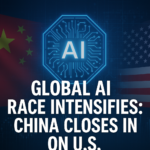
A New Chapter in the Tech Trade War
In a bold and strategic move, the Trump administration has announced a major update to U.S. semiconductor tariffs, shaking up global markets once again. Targeting key chip-producing nations such as China, Taiwan, and South Korea, the updated tariffs are designed to strengthen American leadership in critical technologies—including artificial intelligence (AI), 5G, and defense.
The decision comes as global powers compete to dominate the future of tech. It has reignited fierce debates about protectionism, supply chain security, and the world’s overreliance on a small group of nations for semiconductor manufacturing.
Revisiting Trump’s Tariff Legacy
During his first term, former President Donald Trump aggressively pursued trade restrictions to curb China’s tech dominance. Semiconductor tariffs, first introduced in 2018, were a cornerstone of this strategy.
Now, in 2025, Trump is doubling down. The updated measures widen the scope of affected products, including:
- Microprocessors
- Graphics Processing Units (GPUs)
- Memory chips (DRAM, NAND)
- Semiconductor manufacturing equipment
The goal: boost U.S. chip production, safeguard intellectual property, and reduce reliance on foreign suppliers.
Key Updates in the 2025 Tariff Policy
According to the Office of the U.S. Trade Representative (USTR), the updated policy includes:
- 🔹 25% tariff on imported microchips and integrated circuits
- 🔹 15% duty on semiconductor manufacturing equipment
- 🔹 Stricter scrutiny on imports from firms linked to foreign militaries
- 🔹 18-month waiver program for U.S. firms reliant on foreign chips
The administration describes these measures as “temporary but necessary” to revitalize domestic semiconductor capacity.
Reactions from the U.S. Semiconductor Industry
The response among U.S. chipmakers has been mixed.
- Intel and Micron expressed cautious optimism, seeing this as a chance to expand local manufacturing.
- However, others warned that tariffs alone won’t solve the deeper issues—like lack of skilled labor and high fabrication costs.
“Tariffs alone won’t solve America’s semiconductor supply chain problem. We need sustained investment.”
— John Neuffer, CEO, Semiconductor Industry Association
To address those concerns, the administration also unveiled a $50 billion incentive package for domestic chip manufacturers—offering tax credits, grants, and low-interest loans.
Global Reactions: Diplomatic Strains & Economic Risks
China slammed the move as “economic bullying” and hinted at retaliatory tariffs on rare earth materials—crucial in semiconductor manufacturing.
Taiwan’s TSMC and South Korea’s Samsung, two of the world’s top chipmakers, voiced concerns about supply chain instability.
Europe expressed fears that rising trade barriers could spark a tech cold war, while Japan signaled interest in U.S. dialogue on cooperative semiconductor strategies.
Tech Industry Braces for Impact
From smartphones to smart fridges, every tech company is preparing for turbulence. Industry giants like Apple, Nvidia, and AMD may face:
- 📉 Rising costs
- 🛑 Delayed product launches
- 🔁 Supply chain redesigns
Key sectors expected to feel the ripple effects:
- Consumer electronics
- Automotive (already chip-starved post-COVID)
- AI hardware and data centers
Smaller tech firms may struggle most, lacking the flexibility to navigate new sourcing hurdles.
Market impact:
- NASDAQ fell 2% following the announcement.
- U.S. chipmaker stocks showed mixed performance.
Economists remain divided:
- Some say this will strengthen U.S. manufacturing
- Others fear inflation and supply chain fragmentation
“The semiconductor war isn’t just about chips—it’s about who controls the future of AI and defense tech.”
— Peter Zhao, Tech Analyst
What It Means for Consumers
The biggest question: How will this affect consumers?
📱 Expect higher prices for electronics: phones, laptops, consoles, smart devices.
🚗 Vehicle prices may rise due to chip cost increases.
⌛ Some product releases may be delayed.
However, domestic subsidies could help reduce consumer impact over time—especially if U.S.-based chip production ramps up successfully.
Final Thoughts: What’s Next?
The Trump administration’s new tariff wave could redefine global tech leadership—but the road ahead is complex.
- If paired with sustained investment, it could make the U.S. a chip powerhouse.
- Without infrastructure and workforce support, it could slow innovation and damage international partnerships.
The coming months will be critical for U.S. policy, global diplomacy, and the future of high-tech manufacturing.
🔍 Stay updated on tech policy, AI, and semiconductor news at
👉 TransformInfoAI.com


